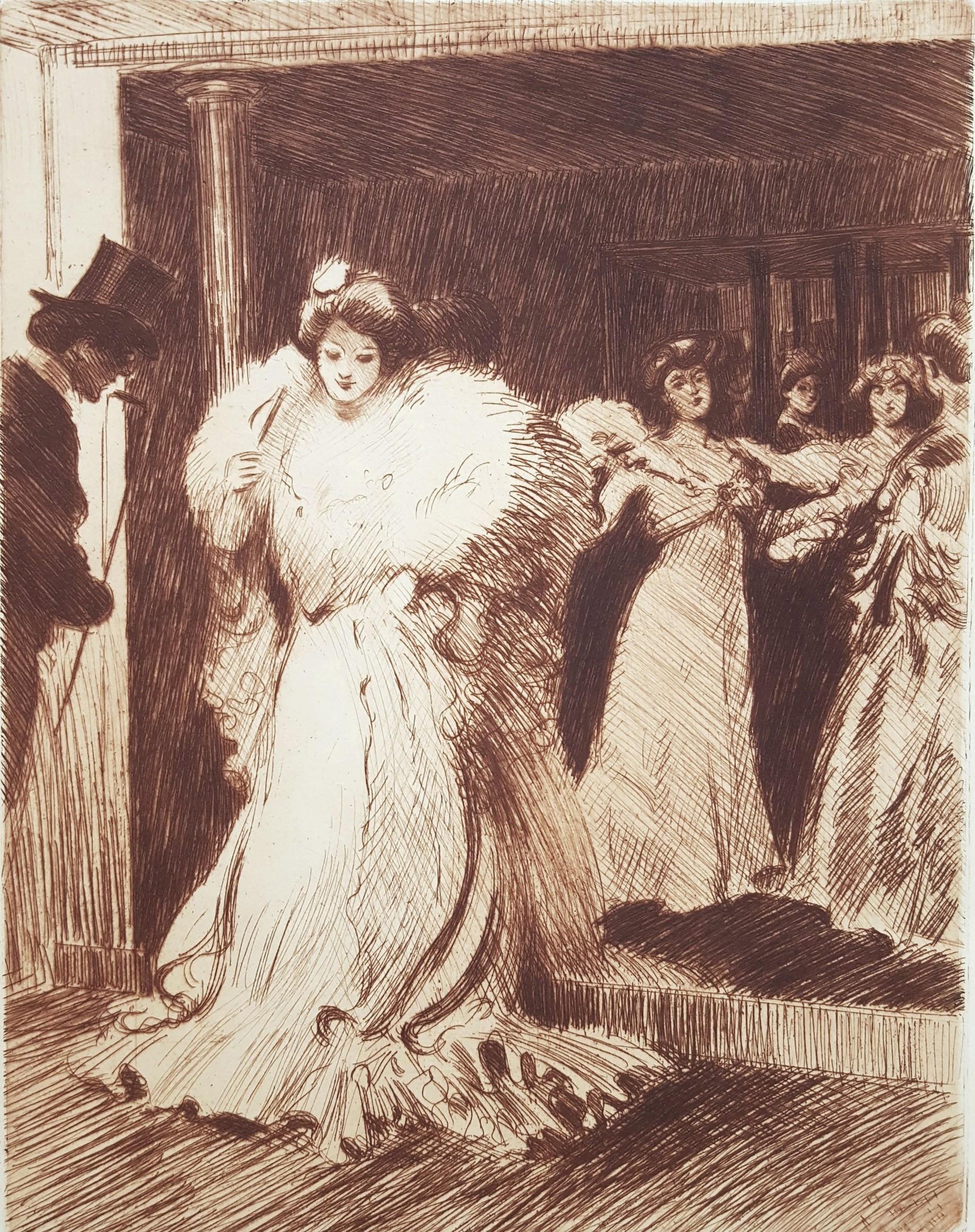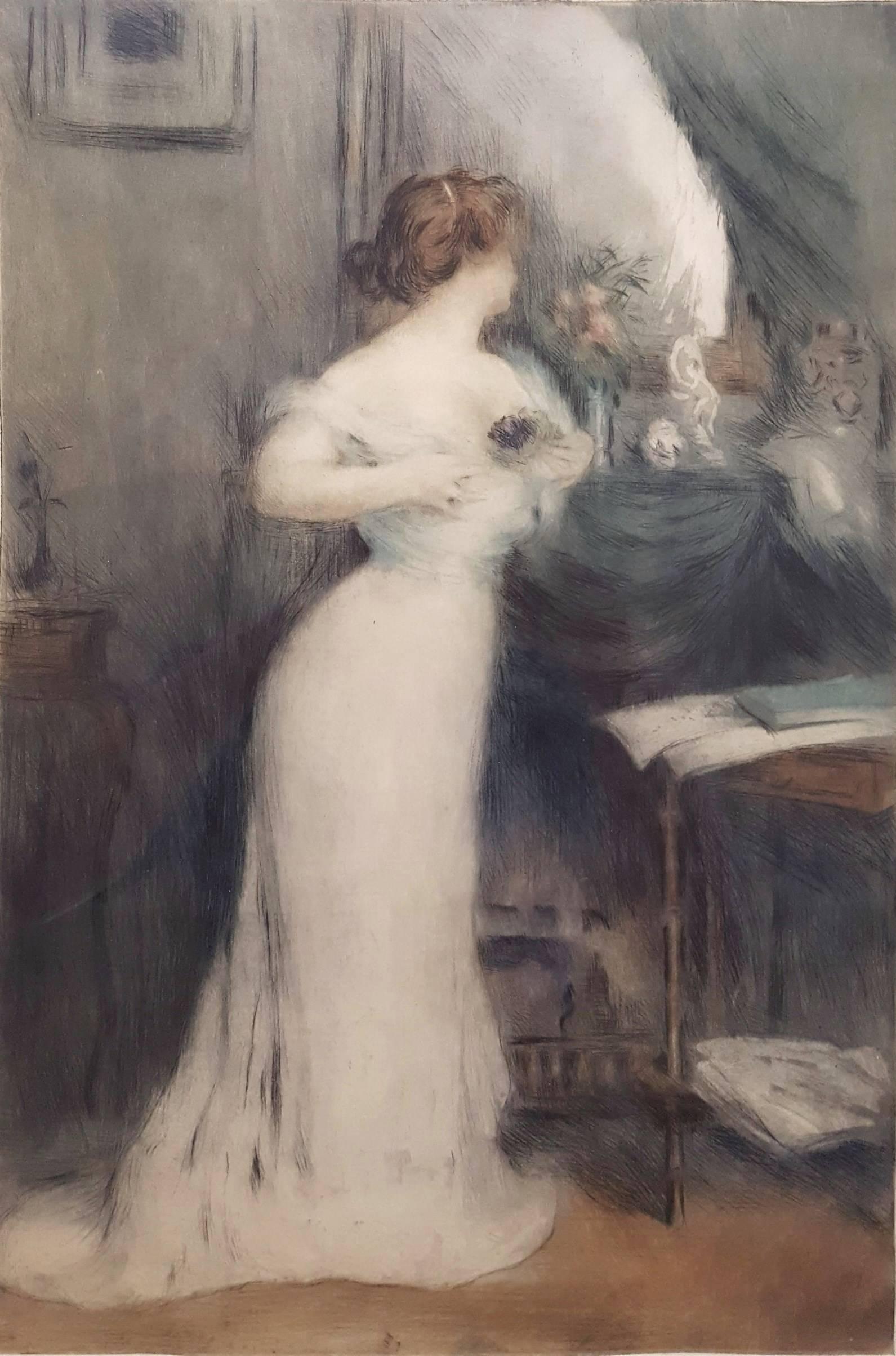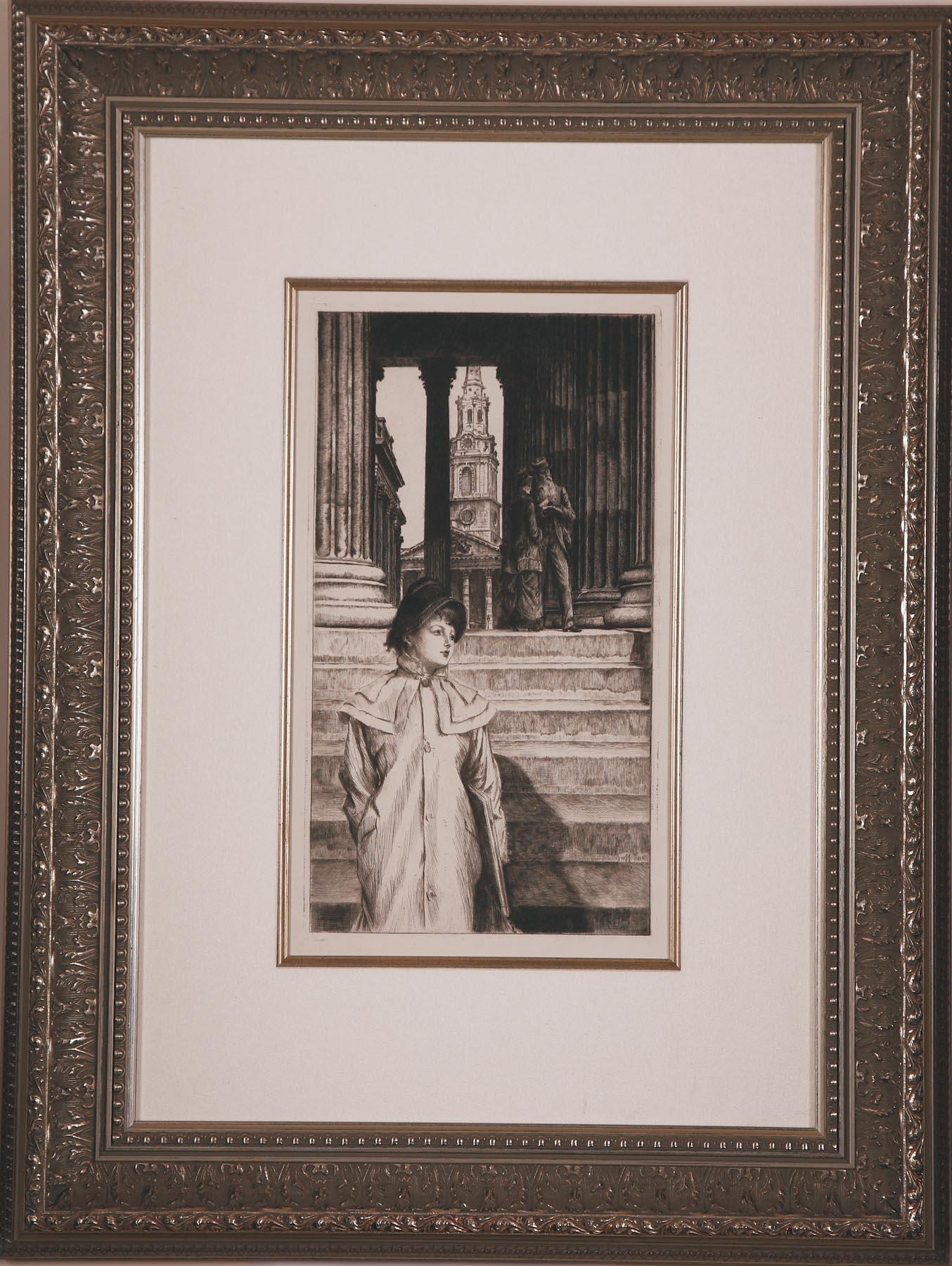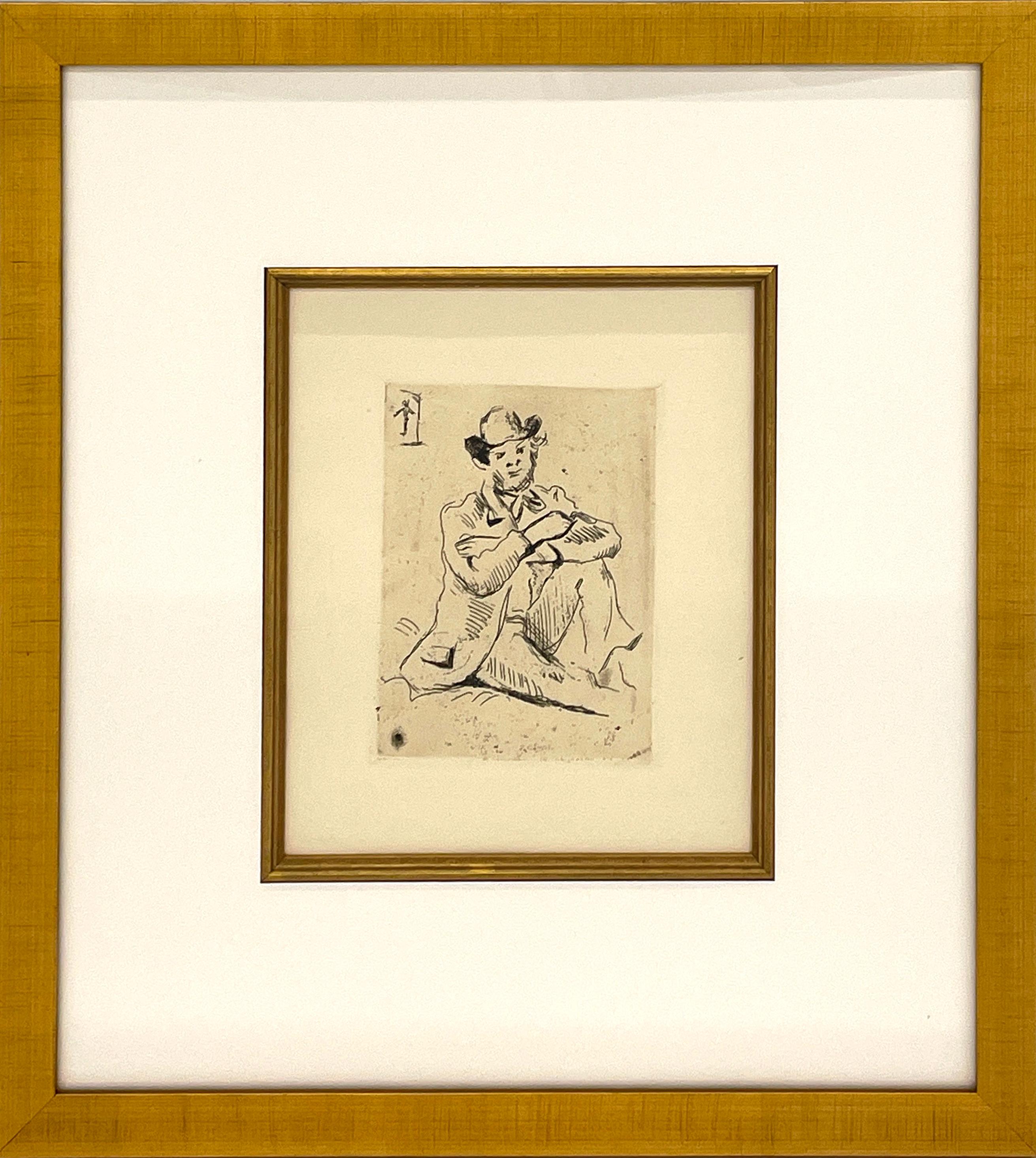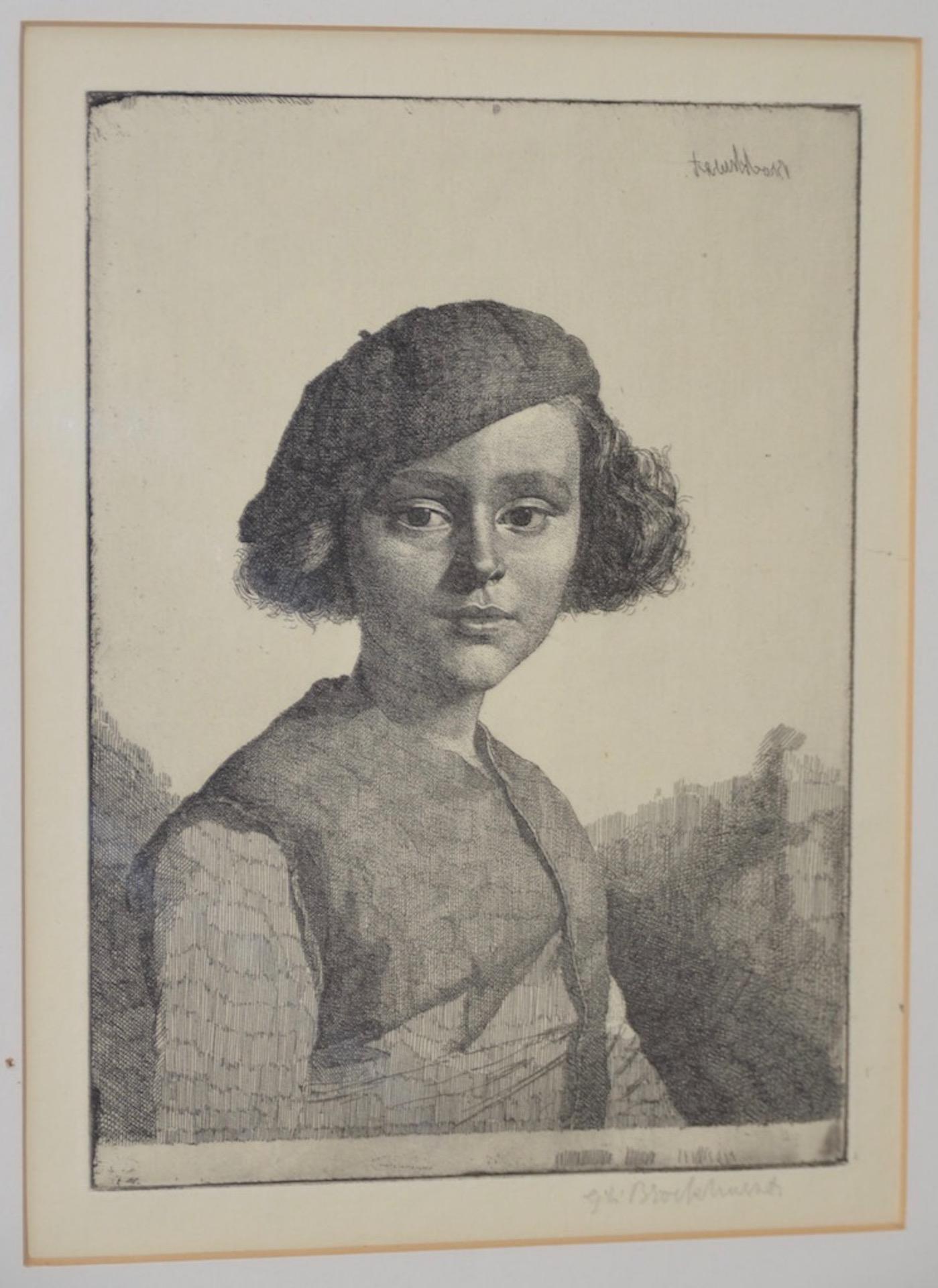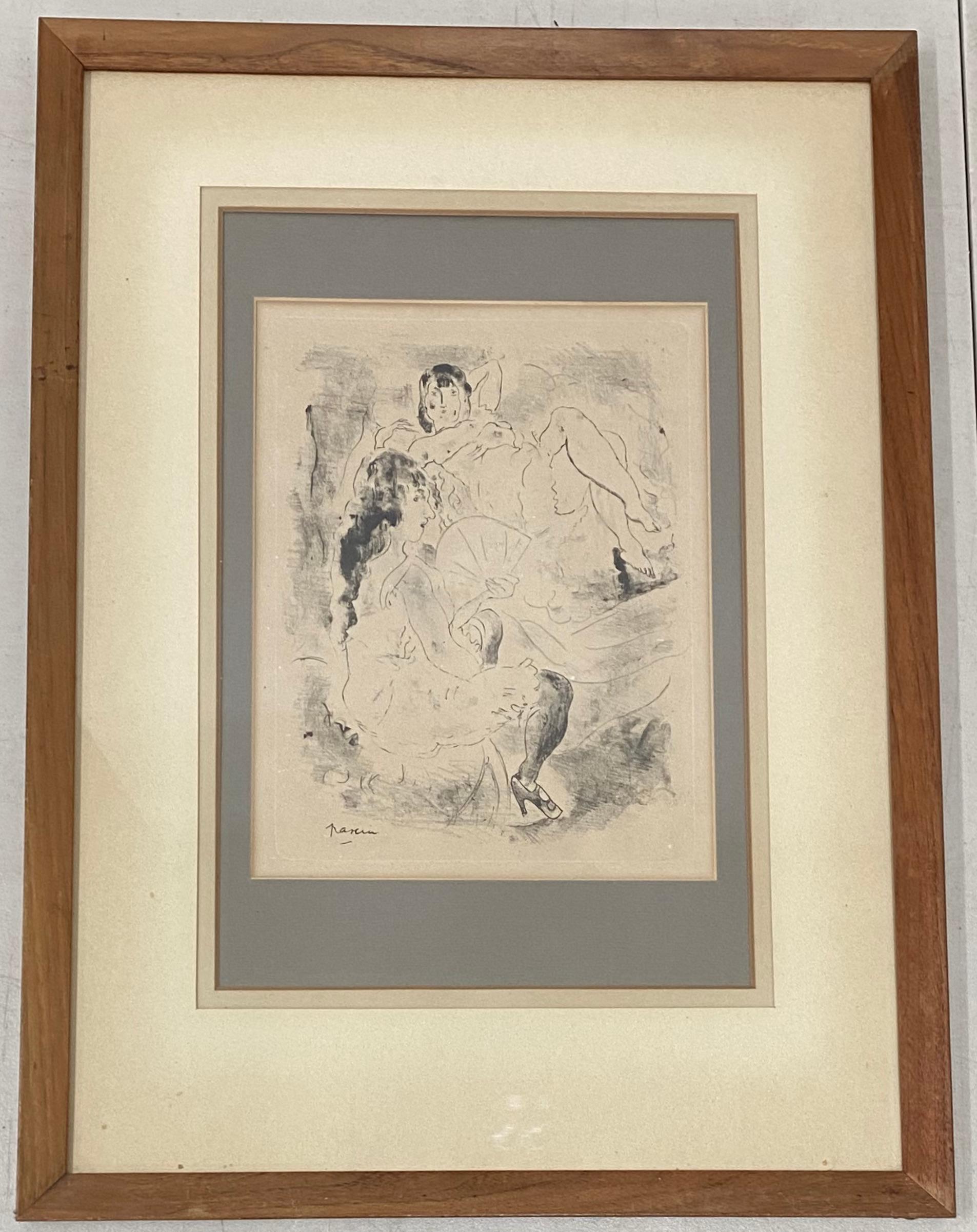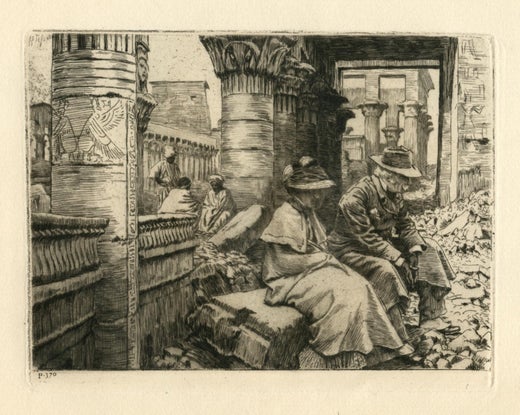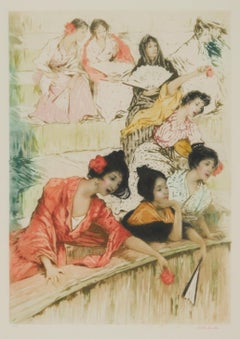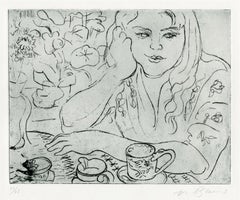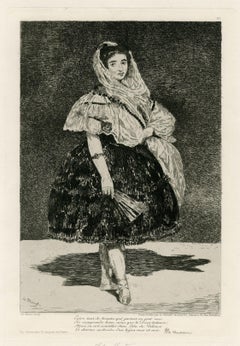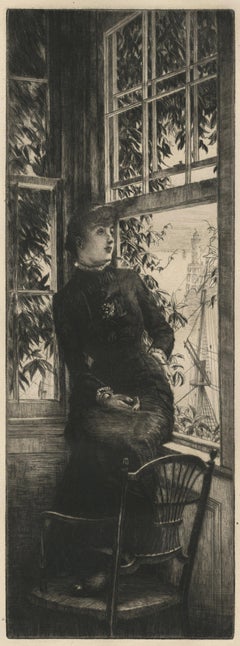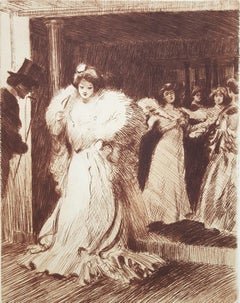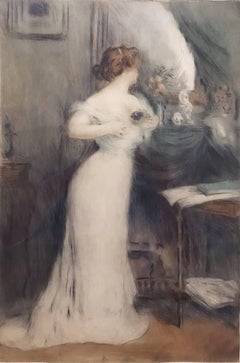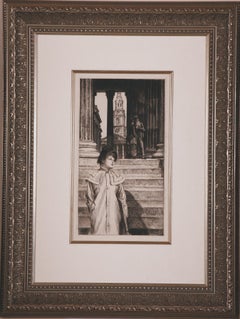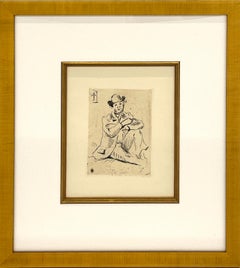Artículos similares a L'enfant prodigue: en pays etranger (The Prodigal Son: In Foreign Climes)
¿Quieres más imágenes o vídeos?
Solicita imágenes o vídeos adicionales al vendedor
1 de 10
James Jacques Joseph TissotL'enfant prodigue: en pays etranger (The Prodigal Son: In Foreign Climes)1881
1881
Acerca del artículo
L'enfant prodigue: en pays etranger (The Prodigal Son: In Foreign Climes)
Etching, 1881
Unsigned (as usual for this state)
From: L'enfant prodigue, (The Prodigal Son, five plates)
Edition: 400 in this state
Total edition: 500
Plate size: 12-1/4 x 14-3/4"
Sheet size: 19 5/8 x 24 1/2 "
Condition: Excellent, usual aging for 100 year old paper
Provenance: Heirs of Edmund Sagot, Paris
Reference: Wentworth 59 ii/II, with the title and caption
Tissot was the recent subject of a major retrospective organized by the Musee D'Orsay, Paris and the Fine Arts Museum of San Francisco. The following is excerpted from their press release:
"James Tissot (1836–1902) was one of the most celebrated French artists during the 19th century, yet he is less known than many of his contemporaries today. Presenting new scholarship on the artist’s oeuvre, technique, and remarkable life, James Tissot: Fashion & Faith provides a critical reassessment of Tissot through a 21st-century lens. The exhibition, co-organized by the Fine Arts Museums of San Francisco and the Musées d’Orsay et de l’Orangerie, Paris, includes approximately 60 paintings in addition to drawings, prints, photographs, and cloisonné enamels, demonstrating the breadth of the artist’s skills. The presentation at the Legion of Honor is the first major international exhibition on Tissot in two decades and the first ever on the West Coast of the United States.
“The work of James Tissot provides a fascinating lens onto society at the dawn of the modern era. Long recognized as a keen observer of contemporary life and fashion, this exhibition brings new light to his narrative strengths and his skill in portraying the emotional and spiritual undercurrents that exist below surface appearances,” states Thomas P. Campbell, Director and CEO of the Fine Arts Museums of San Francisco. “Continuing the Fine Arts Museums’ tradition of contributing original scholarship around key works in our collection, we are thrilled to introduce the perspective of this enigmatic, prolific artist in the first exhibition of his work to take place on the West Coast.”
Tissot’s works have been highly sought after for US collections, and, as such, James Tissot: Fashion & Faith draws from the rich holdings of the Fine Arts Museums of San Francisco; the J. Paul Getty Museum, Los Angeles; the National Gallery of Art, Washington, DC; and numerous private collections, in addition to private and public collections throughout Europe and Canada, including those of Tate, London; the Musées d’Orsay et de l’Orangerie; the Petit Palais, Musée des Beaux-Arts de la Ville de Paris; the Musée d’Arts de Nantes; the National Gallery of Canada, Ottawa; and the Musée des Beaux-Arts de Montréal. In addition, new findings on Tissot’s materials and painting technique—resulting from an extensive, unprecedented study of Tissot paintings and led by the paintings conservation department at the Fine Arts Museums—are revealed in the exhibition. The study was undertaken in collaboration with the Northwestern University/ Art Institute of Chicago Center for Scientific Studies in the Arts (NU-ACCESS) and the Centre for Research and Restoration of the Museums of France.
Arranged chrono-thematically, James Tissot: Fashion & Faithwill trace the extraordinary turns of the artist’s life, as he consistently defied traditional conventions, both professionally and personally. A Frenchman who started out painting medievalized scenes from history and literature, Tissot maintained a complicated friendship with mentee Edgar Degas, went on to adopt an Anglicized version of his name; Jacques, and spent a decade as an expatriate in London, immersing himself in and chronicling modern society. For a time, he ventured into a love affair with the young divorcée Kathleen Newton, who became his model and muse, but, after her tragic premature death, he returned to Paris and spent long periods of productive retreat at his family estate in the French countryside, nurturing a growing, deep commitment to religion.
Tissot’s career spanned the English Channel, garnering commercial and critical success both in London and Paris. Though invited by Degas to exhibit with the Impressionists, Tissot declined. He turned to social events and balls, painting metropolitan life with great attention to detail, humor, and pathos. Upon close study, even his most ebullient society pictures reveal rich and complex commentary on Belle Époque culture, religion, fashion, and politics. The exhibition will include many key modern-life works from his time in London and Paris, such as The Ball on Shipboard (1874), London Visitors (ca. 1874), Holyday (also known as The Picnic; 1876), The Prodigal Son in Modern Life suite (1882), and examples from the La Femme à Paris series (1883–1885).
“James Tissot was technically gifted across a variety of media and he experimented with major trends in art, including Aestheticism and Japonisme, yet his work defies classification and traditional labels,” notes Melissa Buron, exhibition curator and Director of the Art Division at the Fine Arts Museums of San Francisco. “For the past few years, my colleagues and I have been on the trail of Tissot, re-examining works and uncovering previously unpublished information that provides insight into his career, including his sales notebook (carnet de ventes) and hundreds of photographs. Drawing from our findings, James Tissot: Fashion & Faith provides new perspectives on where and how Tissot should be considered in the 19th-century canon.”
As was popular during the late 19th century, Tissot dabbled in mysticism and attended Spiritualist séances. His famous mezzotint from the Fine Arts Museums’ collection, The Apparition (1885), depicts the ghost of Kathleen Newton with a spirit guide as they reportedly appeared to Tissot during a séance. This work and the painting on which it is based—long thought to be lost or destroyed until it was rediscovered in the course of researching this project—are both on view in the exhibition.
Though less is known about the last two decades of Tissot’s life, new scholarship has recently shed light on the final 20 years of his career. During that time, he made three trips to the Holy Land and produced hundreds of watercolors to illustrate the Bible. Wildly popular during Tissot’s lifetime, these religious images became known as the “Tissot Bible” and have since influenced filmmakers from D. W. Griffith (Intolerance, 1916) to William Wyler (Ben-Hur, 1959), as well as Steven Spielberg and George Lucas (Raiders of the Lost Ark, 1981). A selection of biblical watercolors have been lent to the exhibition from the Brooklyn Museum and the Jewish Museum, New York.
Tissot also utilized the relatively new medium of photography by painting from photographs and recording many of his works as well as his home, family, and friends in carefully arranged albums. Photographs from the Fine Arts Museums’ collection in the exhibition, along with recently discovered, never-before-published photographs and a sales notebook published for the first time in the exhibition catalogue, provide a window into Tissot’s life and career, rendering him an artist worthy of reexamination in the 21st century."
- Creador:James Jacques Joseph Tissot (1836-1902, Francés)
- Año de creación:1881
- Dimensiones:Altura: 31,12 cm (12,25 in)Anchura: 37,47 cm (14,75 in)
- Medio:
- Movimiento y estilo:
- Época:
- Estado:
- Ubicación de la galería:Fairlawn, OH
- Número de referencia:Vendedor: FA66891stDibs: LU14016413342
James Jacques Joseph Tissot
Jacques Joseph Tissot (francés: [tiso]; 15 de octubre de 1836 - 8 de agosto de 1902), anglicismo James Tissot (), fue un pintor e ilustrador francés. Fue un pintor de éxito de la sociedad parisina antes de trasladarse a Londres en 1871. Se hizo famoso como pintor de género de mujeres vestidas a la moda mostradas en diversas escenas de la vida cotidiana. También pintó escenas y figuras de la Biblia.
Sobre el vendedor
5,0
Vendedor reconocido
Estos prestigiosos vendedores son líderes del sector y representan el escalón más alto en cuanto a calidad y diseño de artículos.
Vendedor Oro
Vendedores premium que mantienen una calificación de +4,3 y tiempos de respuesta de 24 horas
Establecido en 1978
Vendedor de 1stDibs desde 2013
789 ventas en 1stDibs
Tiempo de respuesta usual: <1 hora
Asociaciones
International Fine Print Dealers Association
- EnvíoRecuperando presupuesto…Envío desde: Fairlawn, OH
- Política de devolución
Partes de esta página se han traducido automáticamente. 1stDibs no puede garantizar la exactitud de las traducciones. El inglés es el idioma predeterminado de este sitio web.
Garantía de autenticidad
En el improbable caso de que haya algún problema con la autenticidad de un artículo, ponte en contacto con nosotros en un plazo de 1 año para recibir un reembolso total. DetallesGarantía de devolución de dinero
Si tu artículo no es como se describe, sufre daños durante el transporte o no llega, ponte en contacto con nosotros en un plazo de 7 días para recibir un reembolso total. DetallesCancelación dentro de las 24 horas
Tienes un período de gracia de 24 horas para reconsiderar tu compra, sin preguntas.Vendedores profesionales aprobados
Nuestros vendedores de primera clase deben cumplir estrictos estándares de servicio para mantener la integridad de nuestros anuncios.Garantía de igualación de precios
Si encuentras que un vendedor publicó el mismo artículo por un precio menor en otro lado, igualaremos ese precio.Entrega global de confianza
Nuestra red de transporte de primera ofrece opciones de envío especializado en todo el mundo, que incluye envío personalizado.Más de este vendedor
Ver todoA la Corrida
A la Corrida
Aguatinta en color, c. 1900
Firmado "Osterlind" abajo a la derecha en lápiz rojo
Anotado: "Nº 96" a lápiz abajo a la izquierda
Edición: unos 100
Publicado por Sagot, Par...
Categoría
Principios del 1900, Impresionista, Impresiones figurativas
Materiales
Acuatinta
Daureen, II
Por Nell Blaine
Daureen, II
Aguafuerte, 1969
Firmado a lápiz abajo a la derecha
Edición: 28 (17/28)
Estado: Excelente
Dos bisagras de estera anterior
Blaine estudió grabado en el Atelier 17 de Nueva...
Categoría
Década de 1960, Impresionista, Impresiones figurativas
Materiales
Grabado químico
1200 US$
Lola De Valence
Por Édouard Manet
Lola De Valence
Aguafuerte, 1862
Firmado en la plancha abajo a la izquierda "Ed Manet"
Impreso en papel chine collee, sin marca de agua
De la primera edición, publicada por Cadart y ...
Categoría
Década de 1860, Impresionista, Impresiones figurativas
Materiales
Grabado químico
Au bord de la mer (Al borde del mar)
Por James Jacques Joseph Tissot
Au bord de la mer (Al borde del mar)
Aguafuerte y punta seca, 1880
Firmado en el borde central izquierdo de la placa (ver foto)
Edición: c. 100
Una impresión muy rica, llena de rebab...
Categoría
Década de 1880, Impresionista, Impresiones figurativas
Materiales
Grabado químico
L'enfant prodigue: en pays etranger (El hijo pródigo: en países extranjeros)
Por James Jacques Joseph Tissot
L'enfant prodigue: en pays etranger (El hijo pródigo: en países extranjeros)
Aguafuerte, 1881
Sin signo (como es habitual para este estado)
De: L'enfant prodigue, (El hijo pródigo, c...
Categoría
Década de 1880, Impresionista, Impresiones figurativas
Materiales
Grabado químico
Trois Esquisses de maternite (Tres estudios de maternidad)
Por Pierre Auguste Renoir
Después de Pierre Auguste Renoir (1841-1919)
Trois Esquisses de maternite (Tres estudios de maternidad)
Heliograbado con aguafuerte sobre papel velinado, 1893
Sin firmar como emitido...
Categoría
Década de 1890, Impresionista, Impresiones figurativas
Materiales
Grabado químico
También te puede gustar
L'Avant-Foyer de l'Opera /// Aguafuerte Impresionista Francés Figurativo Dama Hombre
Por Tony Minartz
Artista: Tony Minartz (francés, 1873-1944)
Título: "L'Avant-Foyer de l'Opera" (La vanguardia de la ópera)
Portafolio: Revue de l'Art Ancien & Moderne
*Issued unsigned
Año: 1903
Sopo...
Categoría
Principios del 1900, Impresionista, Impresiones figurativas
Materiales
Papel verjurado, Entalle, Grabado químico
350 US$ Precio de venta
Descuento del 54 %
Le Bouquet de Violettes (El Ramo de Violetas) /// Impresionista Figurativo
Por Manuel Robbe
Artista: Manuel Robbe (francés, 1872-1936)
Título: "Le Bouquet de Violettes (El Ramo de Violetas)"
*Firmado por Robbe a lápiz abajo a la derecha
Año: 1903
Soporte: Aguafuerte origina...
Categoría
Principios del 1900, Impresionista, Impresiones figurativas
Materiales
Grabado químico, Acuatinta, Acuarela, Papel verjurado, Entalle
1200 US$ Precio de venta
Descuento del 70 %
"Le Portique de la Galerie Nationale a Londres" aguafuerte de Tissot
Por James Jacques Joseph Tissot
TISSOT, JAMES JACQUES JOSEPH
(1836 - 1902)
"La Porticada de la Galería Nacional de Londres"
(Pórtico de la Galería Nacional, Londres)
Wentworth 40
Aguafuerte y punta seca sobre pap...
Categoría
Fines del siglo XIX, Impresionista, Impresiones figurativas
Materiales
Grabado químico
Retrato de Guillaumin (con el ahorcado)
Por Paul Cézanne
CEZANNE, PAUL
(1841 - 1906)
Retrato de Guillaumin (con el ahorcado)
Cherpin 2, c. 1873
Grabado
Único Estado conocido, 1000 ejemplares
Como se publicó en Die Impressionisten...
Categoría
Década de 1870, Impresionista, Impresiones figurativas
Materiales
Grabado químico
Gerald Brockhurst (1890-1978) "Fabian" Aguafuerte firmado a lápiz c.1921
Por Gerald Leslie Brockhurst
Gerald Brockhurst (1890-1978) Aguafuerte firmado a lápiz "Fabian" c.1921
Fino grabado del célebre artista Gerald Brockhurst.
Titulado "Fabián" de una edición de 76.
Este aguafuert...
Categoría
principios del siglo XX, Impresionista, Impresiones de retratos
Materiales
Grabado químico
Jules Pascin (francés, 1885-1930) "Dos mujeres reclinadas" Aguafuerte original C.1920
Por Jules Pascin
Jules Pascin (francés, 1885-1930) "Dos mujeres reclinadas" Aguafuerte original C.1920
Dimensiones del plato 9" de ancho x 12" de alto
Dimensiones del marco 19,5" ancho x 26,5" alto...
Categoría
principios del siglo XX, Impresionista, Impresiones figurativas
Materiales
Grabado químico
